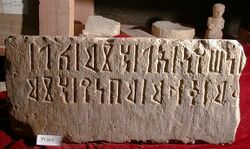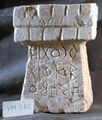Social:Ancient South Arabian script
| Ancient South Arabian script | |
|---|---|
 | |
| Type | Abjad
|
| Languages | Old South Arabian, Ge'ez |
Time period | Late 2nd millennium BCE to 6th century CE |
Parent systems | Egyptian hieroglyphs
|
Sister systems | Ancient North Arabian |
| Direction | Right-to-left |
| ISO 15924 | Sarb, 105 |
Unicode alias | Old South Arabian |
| U+10A60–U+10A7F | |

The Ancient South Arabian script (Old South Arabian: [𐩣𐩯𐩬𐩵] error: {{lang}}: unrecognized private tag: oldsoara (help) [ms3nd] error: {{transl}}: unrecognized language / script code: sem-x-oldsoara (help); modern Arabic: الْمُسْنَد musnad) branched from the Proto-Sinaitic script in about the late 2nd millennium BCE. It was used for writing the Old South Arabian languages Sabaic, Qatabanic, Hadramautic, Minaean, and Hasaitic, and the ancient language of Eritrea, Geʽez in Dʿmt. The earliest instances of the Ancient South Arabian script are painted pottery sherds from Raybun in Hadhramaut in Yemen, which are dated to the late 2nd millennium BCE.[1] There are no letters for vowels, which are marked by matres lectionis.
Its mature form was reached around 800 BCE and its use continued until the 6th century CE, including Ancient North Arabian inscriptions in variants of the alphabet, when it was displaced by the Arabic alphabet.[2] In Eritrea and Ethiopia, it evolved later into the Geʽez script,[3][4] which, with added symbols throughout the centuries, has been used to write Amharic, Tigrinya and Tigre, as well as other languages (including various Semitic, Cushitic, and Nilo-Saharan languages).
Properties
- It is usually written from right to left but can also be written from left to right. When written from left to right the characters are flipped horizontally (see the photo).
- The spacing or separation between words is done with a vertical bar mark (|).
- Letters in words are not connected together.
- It does not implement any diacritical marks (dots, etc.), differing in this respect from the modern Arabic alphabet.
Letters
| Letter[5] | Phoneme | IPA | Corresponding letter in | ||||||||
|---|---|---|---|---|---|---|---|---|---|---|---|
| Ancient North Arabian | Ge'ez | Phoenician | Aramaic | Arabic | |||||||
| [𐩠] error: {{lang}}: unrecognized private tag: oldsoara (help) | h | [h] | 𐪀 | Template:Script/Ethiopic | 𐤄 | [𐡄] error: {{lang}}: unrecognized private tag: aramaic (help) | ه | ||||
| [𐩡] error: {{lang}}: unrecognized private tag: oldsoara (help) | l | [l] | 𐪁 | Template:Script/Ethiopic | 𐤋 | [𐡋] error: {{lang}}: unrecognized private tag: aramaic (help) | ل | ||||
| [𐩢] error: {{lang}}: unrecognized private tag: oldsoara (help) | ḥ | [ħ] | 𐪂 | Template:Script/Ethiopic | 𐤇 | [𐡇] error: {{lang}}: unrecognized private tag: aramaic (help) | ح | ||||
| [𐩣] error: {{lang}}: unrecognized private tag: oldsoara (help) | m | [m] | 𐪃 | Template:Script/Ethiopic | 𐤌 | [𐡌] error: {{lang}}: unrecognized private tag: aramaic (help) | م | ||||
| [𐩤] error: {{lang}}: unrecognized private tag: oldsoara (help) | q | [q] | 𐪄 | Template:Script/Ethiopic | 𐤒 | [𐡒] error: {{lang}}: unrecognized private tag: aramaic (help) | ق | ||||
| [𐩥] error: {{lang}}: unrecognized private tag: oldsoara (help) | w | [w], [uː] | 𐪅 | Template:Script/Ethiopic | 𐤅 | [𐡅] error: {{lang}}: unrecognized private tag: aramaic (help) | و | ||||
| [𐩦] error: {{lang}}: unrecognized private tag: oldsoara (help) | s² (ś) | [ɬ] | 𐪆 | Template:Script/Ethiopic | 𐤔 | [𐡔] error: {{lang}}: unrecognized private tag: aramaic (help) | ش | ||||
| [𐩧] error: {{lang}}: unrecognized private tag: oldsoara (help) | r | [r] | 𐪇 | Template:Script/Ethiopic | 𐤓 | [𐡓] error: {{lang}}: unrecognized private tag: aramaic (help) | ر | ||||
| [𐩨] error: {{lang}}: unrecognized private tag: oldsoara (help) | b | [b] | 𐪈 | Template:Script/Ethiopic | 𐤁 | [𐡁] error: {{lang}}: unrecognized private tag: aramaic (help) | ب | ||||
| [𐩩] error: {{lang}}: unrecognized private tag: oldsoara (help) | t | [t] | 𐪉 | Template:Script/Ethiopic | 𐤕 | [𐡕] error: {{lang}}: unrecognized private tag: aramaic (help) | ت | ||||
| [𐩪] error: {{lang}}: unrecognized private tag: oldsoara (help) | s¹ (š) | [s] | 𐪊 | Template:Script/Ethiopic | س | ||||||
| [𐩫] error: {{lang}}: unrecognized private tag: oldsoara (help) | k | [k] | 𐪋 | Template:Script/Ethiopic | 𐤊 | [𐡊] error: {{lang}}: unrecognized private tag: aramaic (help) | ك | ||||
| [𐩬] error: {{lang}}: unrecognized private tag: oldsoara (help) | n | [n] | 𐪌 | Template:Script/Ethiopic | 𐤍 | [𐡍] error: {{lang}}: unrecognized private tag: aramaic (help) | ن | ||||
| [𐩭] error: {{lang}}: unrecognized private tag: oldsoara (help) | ḫ | [x] | 𐪍 | Template:Script/Ethiopic | خ | ||||||
| [𐩮] error: {{lang}}: unrecognized private tag: oldsoara (help) | ṣ | [sˤ] | 𐪎 | Template:Script/Ethiopic | 𐤑 | [𐡑] error: {{lang}}: unrecognized private tag: aramaic (help) | ص | ||||
| [𐩯] error: {{lang}}: unrecognized private tag: oldsoara (help) | s³ (s) | [s̪] | 𐪏 | 𐤎 | [𐡎] error: {{lang}}: unrecognized private tag: aramaic (help) | ||||||
| [𐩰] error: {{lang}}: unrecognized private tag: oldsoara (help) | f | [f] | 𐪐 | Template:Script/Ethiopic | 𐤐 | [𐡐] error: {{lang}}: unrecognized private tag: aramaic (help) | ف | ||||
| [𐩱] error: {{lang}}: unrecognized private tag: oldsoara (help) | ʾ | [ʔ] | 𐪑 | Template:Script/Ethiopic | 𐤀 | [𐡀] error: {{lang}}: unrecognized private tag: aramaic (help) | ا | ||||
| [𐩲] error: {{lang}}: unrecognized private tag: oldsoara (help) | ʿ | [ʕ] | 𐪒 | Template:Script/Ethiopic | 𐤏 | [𐡏] error: {{lang}}: unrecognized private tag: aramaic (help) | ع | ||||
| [𐩳] error: {{lang}}: unrecognized private tag: oldsoara (help) | ḍ | [ɬˤ] | 𐪓 | Template:Script/Ethiopic | ض | ||||||
| [𐩴] error: {{lang}}: unrecognized private tag: oldsoara (help) | g | [g] | 𐪔 | Template:Script/Ethiopic | 𐤂 | [𐡂] error: {{lang}}: unrecognized private tag: aramaic (help) | ج | ||||
| [𐩵] error: {{lang}}: unrecognized private tag: oldsoara (help) | d | [d] | 𐪕 | Template:Script/Ethiopic | 𐤃 | [𐡃] error: {{lang}}: unrecognized private tag: aramaic (help) | د | ||||
| [𐩶] error: {{lang}}: unrecognized private tag: oldsoara (help) | ġ | [ɣ] | 𐪖 | غ | |||||||
| [𐩷] error: {{lang}}: unrecognized private tag: oldsoara (help) | ṭ | [tˤ] | 𐪗 | Template:Script/Ethiopic | 𐤈 | [𐡈] error: {{lang}}: unrecognized private tag: aramaic (help) | ط | ||||
| [𐩸] error: {{lang}}: unrecognized private tag: oldsoara (help) | z | [z] | 𐪘 | 𐤆 | [𐡆] error: {{lang}}: unrecognized private tag: aramaic (help) | ز | |||||
| [𐩹] error: {{lang}}: unrecognized private tag: oldsoara (help) | ḏ | [ð] | 𐪙 | Template:Script/Ethiopic | ذ | ||||||
| [𐩺] error: {{lang}}: unrecognized private tag: oldsoara (help) | y | [j], [iː] | 𐪚 | Template:Script/Ethiopic | 𐤉 | [𐡉] error: {{lang}}: unrecognized private tag: aramaic (help) | ي | ||||
| [𐩻] error: {{lang}}: unrecognized private tag: oldsoara (help) | ṯ | [θ] | 𐪛 | ث | |||||||
| [𐩼] error: {{lang}}: unrecognized private tag: oldsoara (help) | ẓ | [θˤ] | 𐪜 | ظ | |||||||
Numbers
Six signs are used for numbers:
| 1 | 5 | 10 | 50 | 100 | 1000 |
|---|---|---|---|---|---|
| 𐩽 | 𐩭 | 𐩲 | 𐩾 | 𐩣 | 𐩱 |
The sign for 50 was evidently created by removing the lower triangle from the sign for 100.[6] The sign for 1 doubles as a word separator. The other four signs double as both letters and numbers. Each of these four signs is the first letter of the name of the corresponding numeral.[6]
An additional sign (𐩿) is used to bracket numbers, setting them apart from surrounding text.[6] For example, Template:Rtl𐩿𐩭𐩽𐩽𐩿Template:Ltr
These signs are used in an additive system similar to Roman numerals to represent any number (excluding zero). Two examples:
- 17 is written as 1 + 1 + 5 + 10: Template:Rtl𐩲𐩭𐩽𐩽Template:Ltr
- 99 is written as 1 + 1 + 1 + 1 + 5 + 10 + 10 + 10 + 10 + 50: 𐩾𐩲𐩲𐩲𐩲𐩭𐩽𐩽𐩽𐩽
| 1 | 2 | 3 | 4 | 5 | 6 | 7 | 8 | 9 | 10 |
|---|---|---|---|---|---|---|---|---|---|
| 𐩽 | Template:Rtl𐩽𐩽Template:Ltr | Template:Rtl𐩽𐩽𐩽Template:Ltr | Template:Rtl𐩽𐩽𐩽𐩽Template:Ltr | 𐩭 | Template:Rtl𐩭𐩽Template:Ltr | Template:Rtl𐩭𐩽𐩽Template:Ltr | Template:Rtl𐩭𐩽𐩽𐩽Template:Ltr | Template:Rtl𐩭𐩽𐩽𐩽𐩽Template:Ltr | 𐩲 |
| 11 | 12 | 13 | 14 | 15 | 16 | 17 | 18 | 19 | 20 |
| Template:Rtl𐩲𐩽Template:Ltr | Template:Rtl𐩲𐩽𐩽Template:Ltr | Template:Rtl𐩲𐩽𐩽𐩽Template:Ltr | Template:Rtl𐩲𐩽𐩽𐩽𐩽Template:Ltr | Template:Rtl𐩲𐩭Template:Ltr | Template:Rtl𐩲𐩭𐩽Template:Ltr | Template:Rtl𐩲𐩭𐩽𐩽Template:Ltr | Template:Rtl𐩲𐩭𐩽𐩽𐩽Template:Ltr | Template:Rtl𐩲𐩭𐩽𐩽𐩽𐩽Template:Ltr | Template:Rtl𐩲𐩲Template:Ltr |
Thousands are written two different ways:
- Smaller values are written using just the 1000 sign. For example, 8,000 is written as 1000 × 8: Template:Rtl𐩱𐩱𐩱𐩱𐩱𐩱𐩱𐩱Template:Ltr
- Larger values are written by promoting the signs for 10, 50, and 100 to 10,000, 50,000, and 100,000 respectively:
- 31,000 is written as 1000 + 10,000 × 3: Template:Rtl𐩲𐩲𐩲𐩱Template:Ltr (easily confused with 1,030)
- 40,000 is written as 10,000 × 4: Template:Rtl𐩲𐩲𐩲𐩲Template:Ltr (easily confused with 40)
- 253,000 is written as 2 × 100.000 + 50.000 + 3 × 1000: Template:Rtl𐩣𐩣𐩾𐩱𐩱𐩱Template:Ltr (easily confused with 3,250)
Perhaps because of ambiguity, numerals, at least in monumental inscriptions, are always clarified with the numbers written out in words.
Zabūr
Zabūr, also known as "South Arabian minuscules",[7] is the name of the cursive form of the South Arabian script that was used by the Sabaeans in addition to their monumental script, or Musnad.[8]
Zabur was a writing system in ancient Yemen along with Musnad. The difference between the two is that Musnad documented historical events, meanwhile Zabur writings were used for religious scripts or to record daily transactions among ancient Yemenis. Zabur writings could be found in palimpsest form written on papyri or palm-leaf stalks.[9][10]
Unicode
The South Arabian alphabet was added to the Unicode Standard in October, 2009 with the release of version 5.2.
The Unicode block, called Old South Arabian, is U+10A60–U+10A7F.
Note that U+10A7D OLD SOUTH ARABIAN NUMBER ONE (𐩽) represents both the numeral one and a word divider.[6]
Gallery
- Photos from National Museum of Yemen:
- Photos from Yemen Military Museum:
- Photo from the British Museum
See also
- Ancient North Arabian script
- Arabist and archeologist Eduard Glaser
- Geographer Carl Rathjens
References
Citations
- ↑ Stein, Peter (2013). "Palaeography of the Ancient South Arabian script. New evidence for an absolute chronology". Arabian Archaeology and Epigraphy 24 (2): 186–195. doi:10.1111/aae.12024. ISSN 0905-7196. https://www.academia.edu/7131233.
- ↑ Ibn Durayd, Ta‘līq min amāli ibn durayd, ed. al-Sanūsī, Muṣṭafā, Kuwait 1984, p. 227 (Arabic). The author purports that a poet from the Kinda tribe in Yemen who settled in Dūmat al-Ǧandal during the advent of Islam told of how another member of the Yemenite Kinda tribe who lived in that town taught the Arabic script to the Banū Qurayš in Mecca and that their use of the Arabic script for writing eventually took the place of musnad, or what was then the Sabaean script of the kingdom of Ḥimyar: "You have exchanged the musnad of the sons of Ḥimyar / which the kings of Ḥimyar were wont to write down in books."
- ↑ Cite error: Invalid
<ref>tag; no text was provided for refs namedWorldsWritingSystems89 - ↑ Cite error: Invalid
<ref>tag; no text was provided for refs namedCambridgeAncientLanguages431 - ↑ Official Unicode Consortium code chart
- ↑ Jump up to: 6.0 6.1 6.2 6.3 Maktari, Sultan; Mansour, Kamal (2008-01-28). "L2/08-044: Proposal to encode Old South Arabian Script". https://www.unicode.org/L2/L2008/08044-osa.pdf.
- ↑ Stein 2005.
- ↑ Ryckmans, Müller & ‛Abdallah 1994, p. 43.
- ↑ Ryckmans 1993, p. 127.
- ↑ S. Horovitz, Koranische Untersuchungen, p. 70
References
- Stein, Peter (2005). "The Ancient South Arabian Minuscule Inscriptions on Wood: A New Genre of Pre-Islamic Epigraphy". Jaarbericht van het Vooraziatisch-Egyptisch Genootschap "Ex Oriente Lux" 39: 181–199.
- Stein, Peter (2010). Die altsüdarabischen Minuskelinschriften auf Holzstäbchen aus der Bayerischen Staatsbibliothek in München.
- Beeston, A.F.L. (1962). "Arabian Sibilants". Journal of Semitic Studies 7 (2): 222–233. doi:10.1093/jss/7.2.222.
- Francaviglia Romeo, Vincenzo (2012). Il trono della regina di Saba, Artemide, Roma. pp. 149–155.
- Ryckmans, Jacques (1993). "Inscribed Old South Arabian sticks and palm-leaf stalks: An introduction and a paleographical approach". Proceedings of the Seminar for Arabian Studies 23: 127–140.
- Ryckmans, J.; Müller, W. W.; ‛Abdallah, Yu. (1994). Textes du Yémen Antique inscrits sur bois. Louvain-la-Neuve, Belgium: Publications de l'Institut Orientaliste de Louvain.
External links
- Smithsonian National Museum of Natural History
- Omniglot's entry on South Arabian
- Carved, Signed, Crossed Out – Documents on Wooden Sticks from Ancient South Arabia – Peter Stein – ANE Today – Oct 2022
 |




















